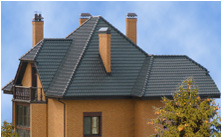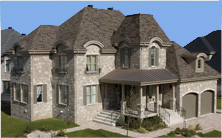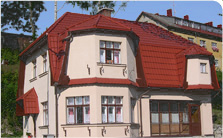Polycarbonate
Issues with polycarbonate
Issues with polycarbonate may arise as the design stage and completion of the transparent cover, and during installation. Most of them are related to insufficient attention being paid designers translucent elements of coverage, and lack of technical information provided by dealers. Description of the material is often reduced to the mean "coverage of cellular polycarbonate 16 mm thick, or to dry, not supported by drawings and technical specifications of the internal list of articles specific manufacturer. Also, errors can be explained by the desire to reduce costs.
Design
When choosing a panel to guide the load carrying capacity and heat characteristics. It is necessary to consider not only the thickness of the panel, but its mass and structure (number of walls, shape, pitch and location of the edges), as even a panel of the same thickness but different geometry of the section or mass may have different strength and resistance to heat. Using a panel at the carrying capacity than necessary, may destroy the coating under the influence of snow and wind loads. To rectify the consequences of the panel to choose a thicker, more mass or reinforced section, a step to reduce supporting structures or change the scheme bearing, using reinforced connecting profile.
Raising the arch should be, choosing a certain thickness, to check compliance with the minimum bend radius projected. In this case, better to leave a reserve (minimum bend radius of the panel should be slightly smaller than the radius of construction), as in the manufacture and installation of supporting structures likely to reject, and "bend" the panel may be damaged under the influence of internal pressure or a sharp decrease in toughness of the material. To prevent this, we must choose the panel thinner, or with fewer walls, change the geometry of the structure, reducing its curvature.
Thermal calculation of the light transmitting structures remains the most difficult stage in the design. Existing regulations do not contain information on the thermal resistance of the roof, consisting of all light transmitting materials. The required thermal resistance of the lamps is too low, he with a margin satisfy even the panel thickness 4 mm, and for warm roof - too high, it can not be obtained, even using the panel thickness of 40 mm, superior in its characteristics, any of the commonly used double-glazed windows. In addition, the creation of translucent design with warm thermal technical characteristics of the roof causes the snow is not melted: covering the winter period ceases to transmit light, frost increases the load. Therefore, often when calculating the necessary thermal characteristics must be guided by experience and common sense.
Nonprofessional calculation leads to piromerzaniyu design, sweat glazing elements, reducing the room temperature, increased heat loss that can be corrected only by selecting the panel of greater thickness, or with lots of walls and diagonal ribs, or install a second layer of glazing.
Less serious but no less common errors related to the optical properties of the panels. Since the panels of different colors have different light transmission, with a choice of color need to consider not only the appearance of design, but also the desired color spectrum and the coefficient of light in the room.
As an example the case when the client is not told about the appointment of an object, bought the blue panel. After some time after the material has been installed, the customer came back to replace it with a transparent or white. It was found that polycarbonate coated meat ranks in the food market. Meat with sun through the blue panel, had the appropriate shade, sales slowed markedly, the owners were forced to change the cover on the panel of neutral shades.
Panels of bright colors is not recommended for use in indoor shopping centers, exhibition halls and other buildings in which it is important to preserve the natural colors of the interior. However, polycarbonate is catchy colors advantageous to use for roofs over gas station, car parking, bus stop complex, the construction of sports and industrial facilities.
Keep in mind that polycarbonate several times the insolation areas by increasing the glazing area, so that even opal or dark-colored panels of great thickness, with 30-40% light transmission, provide a significant increase in lighting and heating by solar energy. In combination with the ability to skip polycarbonate "short" infrared rays of the sun and reflect the "long" radiated by the device heating and warmed up for the day home furnishings, it helps reduce costs for space heating. During the hot months, it can lead to overheating of the premises, especially on the south side of buildings. Therefore, the construction in the southern regions it makes sense to use the special panel, containing mica or metallic powder and absorb or reflect solar heat.
Errors in the application of polycarbonate may be associated with a mismatch projected load-bearing structures real properties of panels and the technology of their erection.
Completion
Often, issues with polycarbonate due to the fact that the estimates lay only an approximate cost of components, taken as usual at a rate of 10-15% of the cost of panels, whereas in reality the cost of accessories can reach 50-100% of the cost of polycarbonate. Only the detailed design and preparation of sites detailed specifications of the customer and the contractor will insure against unforeseen increase in the estimated project cost.
The contractor has to yourself and the shortage of time and money to select the connection profiles, gaskets and sealants, which often affect the timeliness of delivery of the object, quality of work and often leads to leaks and forced refinements coverage after commissioning.
Connectors and mounting profiles have on the performance of construction not less impact than the panel, and on their quality and meet the requirements depends on carrying capacity, integrity and insulation coatings. About how to choose the profiles in detail in the previous issue of the magazine.
Step fasteners made by calculation or, if the loads are small - constructively. If the hardware put less than required, may decrease the bearing capacity of coverage, up to structural failure (rupture of screws, polycarbonate collapse at fixing in arch structures - buckling of sheets). If the hardware put more than necessary, increasing the estimated cost, an increasing number of holes in the coating and aggravated deformation due to thermal expansion of the panels.
Incomplete design documentation, or an elementary desire to save money often leads to replacement of materials at lower cost, irrelevant to this project or with reduced consumer properties.
The warranty on the panel is not a panacea, because for many manufacturers is easier to change a failed cheap goods to the same than to establish high-quality products, the more that do not always end the client finds the producer of the material, especially a few years after the sale.
Signs of poor quality material:
• Lack of brand and recommendations for installation on the protective film;
• lack of data on weight-bearing ability, UV protection. UV protection is visible to the naked eye - the side facing the sun, has a slight bluish glow on the cut. If this effect is not observed, the presence of coextruded UV protection is questionable; variations in linear dimensions and the thickness of the sheet;
• Increased corrugated sheets that are visible to the naked eye, longitudinal or transverse striations on the leaf surface. They indicate that deviations in the extrusion process, which may affect the carrying capacity of leaves;
• foreign inclusions, black spots, blisters, surface roughness. These signs indicate that the material used a lot of recycled materials, which reduces the strength and durability of the sheets;
• yellowish or bluish tint transparent panels. This sign indicates that this material belongs to the economy class (with UV protection in the thickness of a sheet that is worse than a coextruded outer protection, or with reduced mass). Need to clarify with the seller of this specific material and its application area.
No less should be treated responsibly and to the choice of components. Seals must be made of EPDM (not made of rubber or PVC) washers - metal or PVC (not polyethylene). Profiles should be of sufficient width, thickness and strength of polycarbonate - the UV-protection. Screws should be made of quality steel, corrosion-resistant coating and have sufficient thickness.
Reducing the number of components (increase step of connecting the profile and other fasteners) are also negatively affect the operational characteristics of the coating. Data on the carrying capacity of panels, reported by the manufacturer, are valid only if they meet the recommended schemes bearing and fastening polycarbonate.
Storage
Folding sheets in a roll radius is less than acceptable, leads to cross-creases on the sheets and the loss of their carrying capacity. For prolonged storage panels, set vertically on one side, it is possible deformation and creases sheets.
When storing the sheets of the open glue, which is attached a protective plastic film, sunlight can be "prikipet" to the panel and subsequently removing the film would be difficult, but the panel may remain spot of glue. Film must be removed immediately after installation panel. If the panel is turned to the sun side without UV protection, it will begin to turn yellow.
Storage of sawn sheets with exposed ends face the fact that the cell can get dust, dirt, moisture and insects.
Assembly
Various schemes bearing panels: the rafters on purlins or four sides. For fixing panels of modular systems can be used only runs as connecting profile in this case either absent or did not actually visible. Depending on initial conditions can be matched by a given panel support frame (you can order a panel of the desired width at the factory, but this will increase delivery time and transportation costs) or to change the pitch of supports based on the selected panel. It is required to consider not only the strength characteristics of the panels, but also a necessary step mounting panels and connecting the profile of hardware.
In case of horizontal arrangement of stiffeners appears in the panel condensate instead removed along the honeycomb panel is stored in up to fill hundreds of water. In this case, rather quickly in a humid environment is put mildew, algae, blacken the panel. When placing the panels UV protection into the design panel is yellow and may subsequently collapse. Yellowed panels must be replaced in time.
On the protective film on the outer side panels affixed labels and logos of the manufacturer, the inner side is covered with a film without a pattern - a common standard. Typically, when the thickness of sheet of 8 mm outer side can be easily distinguished even without a film by local pairing with ribs and large wall thickness.
The difference in color-tinted panels installed one style, also speaks about the wrong location of UV protection. UV coat No distribution washers, sealing tape, trim and butt negrammotny cover with a pediment has led to a rapid loss of integrity of the geometric design began nakaplivatsya Moisture in the panel are already in the process of installation due to horizontal position rib a few changes the spectrum that passes through the panel, the color panel, though slightly, depending on what side she turned to the sun (especially noticeable in opal panels). You should verify that the location of panels and fix the problem.
Exceeding the permissible limits of the bending of panels leads to the appearance of creases, the material loses its strength and appearance. It can happen immediately, but over time, under the influence of solar heat, frost, snow and wind loads and thermal expansion.
Unintended manufacturer installation techniques (bend notched, welding, gluing, bending along the ribs and the like) is removed from the manufacturer's warranty and change the operational characteristics of the panels. Heating and destroy many types of glue UV protection, bending along the edges leads to a sharp loss of strength, a hall, etc.
Transverse creases and cracks, if not associated with transport and storage conditions, talk about non-compliance with the bending radius. The longitudinal creases and cracks also often occur during transportation. If they appeared after the installation, then either the panel does not meet the requirements for carrying capacity, or there are deviations in the geometry of the structure (trusses or tie profiles do not lie in one plane).
The reason for accumulation of dust in honeycomb panels - no dust tape. More obvious would be the consequences for small slopes or horizontal arrangement of ribs.
Congestion in the honeycomb panels of water may be due to inadequate slope, horizontal edges, improper protective tape, lack of drainage holes in the trim.
No gap to compensate for thermal expansion between the end panels and other elements of the design is too big a step of connecting the profile is too small holes under the screws cause warping of sheets.
Leakage at fixing screws panels can be caused by incorrectly selected washers tightly screwed screws, screw axis deviation from the perpendicular to the panel. Leakage along the connection profile may indicate that not the right profile or seal, there are deviations in the geometry of the structure, not enough screws that secure the clamp aluminum profile to the base, cover loosely adhere to the base polycarbonate profile.
The characteristic crack of the collected construction occurs during the thermal expansion of panels when sealing longitudinal joints used silicone.
The emergence of modular systems on the market, polycarbonate covers much insures the consumer of these errors, but in any case it is necessary to consult specialists with experience working with polycarbonate, yet at the stage of the project, not after the discovery of leaks on the mounted surface.
Source: Anton Debabov, managing director of the Moscow branch of Politec Polimeri Tecnici journal "Evolution of the roof» / evoroof.ru





